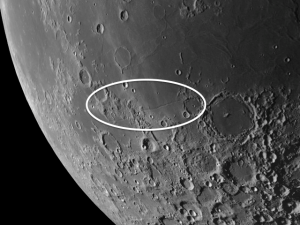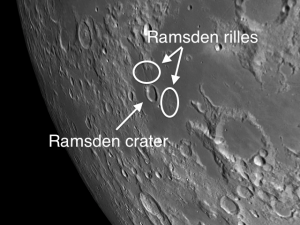 The week of June 1-7 takes us from Lunar Day 10 to Day 17. This week we will highlight two rilles: Rima Hesiodus and Rimae Ramsden.
The week of June 1-7 takes us from Lunar Day 10 to Day 17. This week we will highlight two rilles: Rima Hesiodus and Rimae Ramsden.
Rima Hesiodus: [SW/N7-M8; L=20°W] The linear rille Rima Hesiodus is a graben (a special type of sunken parallel fault line) which connects with its namesake crater on its eastern end and extends in a straight line for nearly 200 miles to the southwest across the  charmingly named Palus Epidemiarum (the “Marsh of Epidemics”).
charmingly named Palus Epidemiarum (the “Marsh of Epidemics”).
Rimae Ramsden: [SW/N6-7] If you continue following Rima Hesiodus to the southwest it will point to Rimae Ramsden, a network of rilles just east of the crater Ramsden. Like the Triesnecker rilles [Day 6/J10], scientists have no explanation of how they got there. 
OF ADDITIONAL INTEREST ABOUT THE MOON:
For those who are new to this blog, the author has written a book on observing the Moon entitled What’s Hot on the Moon Tonight? The Ultimate Guide to Lunar Observing. It is a nightly guide to the Moon’s most interesting features as they are revealed throughout the lunar month. It is highly recommended that you also obtain Sky & Telescope’s Field Map of the Moon, available at https://www.shopatsky.com/sky-and-telescope-field-map-of-the-moon. Lunar features that are described in the book are keyed to the grid in the Field Map.
I was fortunate in that Charles Wood, author of The Modern Moon: A Personal View, a writer for Sky & Tel, and the country’s leading authority on lunar observing was willing to write the foreword. The book is available on Amazon and from my website, AndrewPlanck.com. (If you would like a signed copy, please order from my website).
An e-book version of What’s Hot on the Moon Tonight is now available on iTunes and Amazon. An additional feature is that in the e-book version the longitude of lunar objects has been added to the grid reference, e.g., Plato: [NW/D9; L=9°W], meaning open the Field Map to the NW quadrant, grid D9; Plato is at longitude 9°W. The longitude of a feature is enormously helpful when you are planning a night’s observation because any object which is within 15° or so of the terminator will stand out with astonishing detail1!
1 To find out what the longitude of the terminator will be for any night, download the free Virtual Moon Atlas onto your computer. Set the date to the night you wish to observe, then click on a crater on the terminator and read its longitude. Or use the Moon Map Pro app if you are lucky enough to have gotten it before it became unavailable on iTunes.
======================
It is highly recommended that you get a copy of Sky and Telescope’s Field Map of the Moon, the very finest Moon map available for use at the telescope. It is available for $10.95 at www.skyandtelescope.com and on Amazon. All features mentioned in this blog will be keyed to the grid on the Field Map and will look like this: Plato: [NW/D9]
Credits:
Courtesy of Gray Photography of Corpus Christi, Texas
Lunar photos: NASA / USGS / BMDO / LROC / ASU / DLR / LOLA / Moon Globe. Used by permission
- Rupes Cauchy: A Best Known Fault on the Moon - July 22, 2024
- Moon Crater Schickard – Crater Floor has Stripes - July 15, 2024
- Moon Craters Langrenus and Vandelinus - July 8, 2024